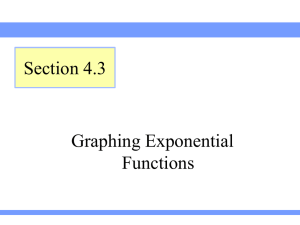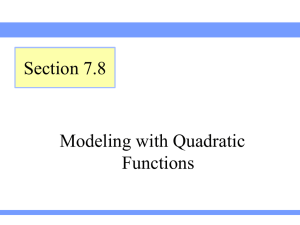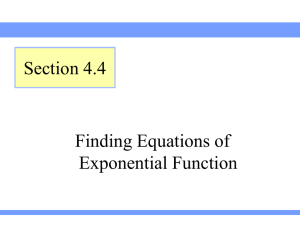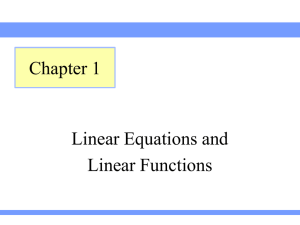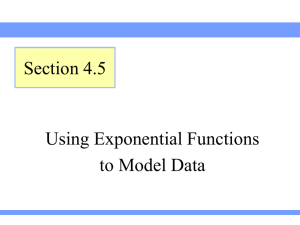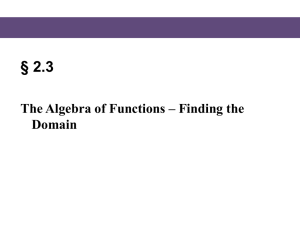10-APP-Making Predictions
advertisement
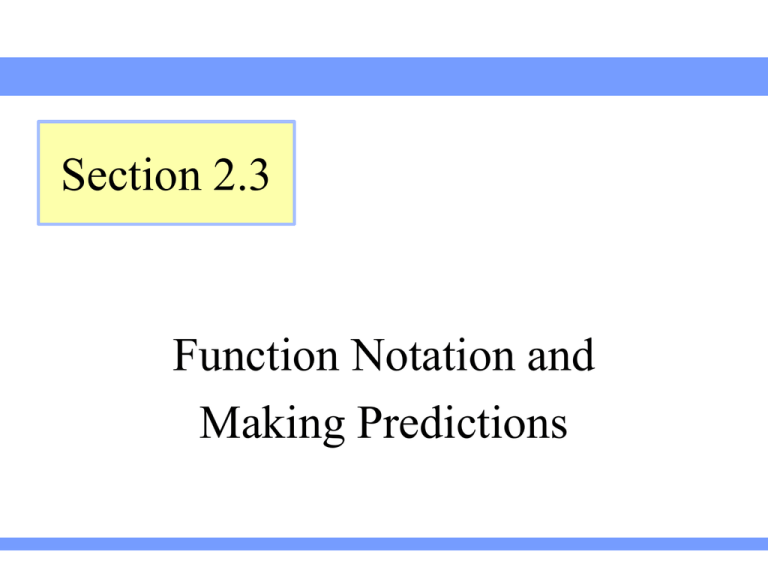
Section 2.3 Function Notation and Making Predictions Using an Equation of a Linear Model to Make Predictions Using Function Notation with Models Example The table shows the average salaries of professors at fouryear colleges and universities. Let s be the professors’ average salary(in thousands of dollars) at t years since 1900. A possible model is s 1.71t 113.12 1. Verify that the above function is the model. Section 2.3 Lehmann, Intermediate Algebra, 4ed Slide 2 Using an Equation of a Linear Model to Make Predictions Using Function Notation with Models Solution • Graph the model and the scattergram in the same viewing window • Function seems to model the data well Example Continued 2. Rewrite the equation s 1.71t 113.12 with the function name f. Section 2.3 Lehmann, Intermediate Algebra, 4ed Slide 3 Using an Equation of a Linear Model to Make Predictions Using Function Notation with Models Solution • t is the independent variable • s is the dependent variable • f is the function name, so we rewrite s f t • Substitute f t for s: f t 1.71t 113.12 Example Continued 3. Predict the average salary in 2011. Section 2.3 Lehmann, Intermediate Algebra, 4ed Slide 4 Using an Equation of a Linear Model to Make Predictions Using Function Notation with Models Solution • Represent the year 2011 by t 1 1 1 • Substitute 111 for t into f t 1.71t 113.12 Example Continued 4. Predict when the average salary will be $80,000. Section 2.3 Lehmann, Intermediate Algebra, 4ed Slide 5 Using an Equation of a Linear Model to Make Predictions Using Function Notation with Models Solution • Represent average salary of $80,000 by s 80 • Since s f t , substitute 80 for f t and solve for t Section 2.3 Lehmann, Intermediate Algebra, 4ed Slide 6 Using an Equation of a Linear Model to Make Predictions Using Function Notation with Models Graphing Calculator • According to model, average salary will be $80,000 in 1900 113 2013 • Using TRACE verify the predictions Section 2.3 Lehmann, Intermediate Algebra, 4ed Slide 7 Using an Equation of a Linear Model to make Predictions Using Function Notation with Models Summary • When making a prediction about the dependent variable of a linear model, substitute a chosen value for the independent variable in the model. Then solve for the dependent variable. • When making a prediction about the independent variable of a linear model, substitute a chosen value for the dependent variable in the model. Then solve for the independent variable. Section 2.3 Lehmann, Intermediate Algebra, 4ed Slide 8 Four-Step Modeling Process Using Function Notation with Models Process To find a linear model and make estimates and predictions, 1. Create a scattergram of data to determine whether there is a nonvertical line that comes close to the data points. If so, choose two points (not necessarily data points) that you can use to find the equation of a linear model. 2. Find an equation of your model. Section 2.3 Lehmann, Intermediate Algebra, 4ed Slide 9 Four-Step Modeling Process Using Function Notation with Models Process 3. Verify your equation by checking that the graph of your model contains the two chosen points and comes close to all of the data points. 4. Use the equation of your model to make estimates, make predictions, and draw conclusions. Section 2.3 Lehmann, Intermediate Algebra, 4ed Slide 10 Using Function Notation; Finding Intercepts Finding Intercepts Example In an example from Section 2.2, we found the equation p. 0.53 t 74.50 , where p is the percentage of American adults who smoke and t years since 1990. 1. Rewrite the equation p 0.53 t 74.50 with the function name g. Section 2.3 Lehmann, Intermediate Algebra, 4ed Slide 11 Using Function Notation; Finding Intercepts Finding Intercepts Solution • To use the name g, substitute g t for p: g t 0.53 t 74.50 Example Continued 2. Find g 110 . What does the result mean in this function? Solution • Substitute 110 for t in the equation g t 0.53 t 74.50 : Section 2.3 Lehmann, Intermediate Algebra, 4ed Slide 12 Using Function Notation; Finding Intercepts Finding Intercepts Solution Continued • When t is 110, p is 16.2. According to the model, 16.2% of American adults will smoke in 2010. Example Continued 3. Find the value of t when g t 30 . What does is mean in this situation? Section 2.3 Lehmann, Intermediate Algebra, 4ed Slide 13 Using Function Notation; Finding Intercepts Finding Intercepts Solution • Substitute 30 for g t in the equation and solve for t • When t is 110, p is 16.2. According to the model, 16.2% of American adults will smoke Example Continued Section 2.3 Lehmann, Intermediate Algebra, 4ed Slide 14 Using Function Notation; Finding Intercepts Finding Intercepts Solution Continued • The model estimates that 30% of Americans smoked in 1900 83.96 1984 • Verify work on graphing calculator table Example Continued 4. Find the p-intercept of the model. What does it mean in this situation? Section 2.3 Lehmann, Intermediate Algebra, 4ed Slide 15 Using Function Notation; Finding Intercepts Finding Intercepts Solution • Since the model g t 0.53 t 74.50 is in slopeintercept form the p-intercept is (0, 74.50) • The model estimates that 74.5% of American adults smoked in 1900 • Research would show that this estimate is too high model breakdown has occurred Example Continued 5. Section 2.3 Find the t-intercept. What does it mean? Lehmann, Intermediate Algebra, 4ed Slide 16 Using Function Notation; Finding Intercepts Finding Intercepts Solution • To find the t-intercept, we substitute 0 for g t and solve for t: Section 2.3 Lehmann, Intermediate Algebra, 4ed Slide 17 Using Function Notation; Finding Intercepts Finding Intercepts Solution Continued • The t-intercept is (140.57, 0) • So, the model predicts that no Americans adults will smoke in 1900 140.57 2041 • Common sense suggest this probably won’t occur • Use TRACE to verify the p- and i-intercepts. Section 2.3 Lehmann, Intermediate Algebra, 4ed Slide 18 Intercepts of Models Finding Intercepts Property If a function of the form p m t b , where m 0 , is used to model a situation, then • The p-intercept is (0, b). • To find the coordinate of the t-intercept, substitute 0 for p in the model’s equation and solve for t. Section 2.3 Lehmann, Intermediate Algebra, 4ed Slide 19 Making a Prediction U s i n g D a t a D e s c r i b e d i n Wo r d s t o M a k e P r e d i c t i o n s Example Sales of bagged salads increased approximately linearly from $0.9 billion in 1996 to $2.7 billion in 2004. Predict in which year the sales will be $4 billion. Solution • Let s be the sales (in billions of dollars) • Let t be the years since 1990 • We want an equation of the form s m t b Section 2.3 Lehmann, Intermediate Algebra, 4ed Slide 20 Making a Prediction U s i n g D a t a D e s c r i b e d i n Wo r d s t o M a k e P r e d i c t i o n s Solution Continued • First find the slope m 2.7 0.9 14 6 0.23 • Substitute 0.23 for m: s 0.23 x b • To find b we substitute 6 for t and 0.9 for s Section 2.3 Lehmann, Intermediate Algebra, 4ed Slide 21 Making a Prediction U s i n g D a t a D e s c r i b e d i n Wo r d s t o M a k e P r e d i c t i o n s Solution Continued • Then substitute –0.48 for b: s 0 .2 3 t 0 .4 8 • To predict when the sales will be $4 billion, we substitute 4 for s in the equation and solve for t: Section 2.3 Lehmann, Intermediate Algebra, 4ed Slide 22 Making a Prediction U s i n g D a t a D e s c r i b e d i n Wo r d s t o M a k e P r e d i c t i o n s Solution Continued • The model predicts that sales will be $4 billion in 1990 19 2009 • Verify using a graphing calculator table Section 2.3 Lehmann, Intermediate Algebra, 4ed Slide 23
